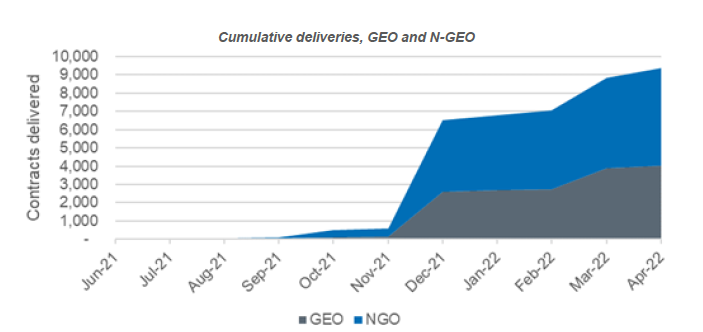The year that was 2021
We can potentially earmark 2021 to clearly segregate the intensity of the global climate efforts into two distinct eras.
For instance, CBL (the largest carbon exchange) in January 2022 announced its transactions in carbon offsets in 2021 exceeded 121.5 million metric tonnes of carbon dioxide equivalent, up 288% from 2020.
This was driven by a variety of factors converging to push the market towards its next stage of growth:
- High carbon credit prices
- Focus on carbon offsets at COP26 in Glasgow
- Launch of a carbon derivatives market
While the former two did their bit in further accelerating the market growth incrementally, the launch of a derivatives market is what fundamentally usurped the market dynamics for good.
CME launches the first ever Carbon futures
CME group, the world's largest exchange of financial derivatives, launched the first futures market for voluntary carbon in 2021. The instrument saw organic adoption by the market. Owing to higher prices and increased volatility, many were motivated to hedge their exposure, while corporate entities moved to lock in forward prices to ensure they receive certificates in the future at a pre-agreed rate.

The warm welcome afforded by the market participants to the launch is a testimony to the fact that it was a natural next step.
The natural evolution of a commodity market
Owain Johnson, the Global Head of Research and Product Development at CME Group, brilliantly summarised his take on a maturing commodity market as below:
There is a well-worn path for market development in the commodities sector. The initial market structure is typically a long-term sales agreement between a buyer and a seller. This is often followed by a trend towards shorter-term ‘spot’ sales, sometimes linked to a published floating price, which then often leads in time to the development of more sophisticated risk management tools such as futures and options.
The voluntary carbon market has been closely following this very standard model of market development. The key difference is that the structures that took decades and even centuries to develop in the traditional commodity markets are developing in voluntary carbon at a significantly faster pace, with major changes and new mechanisms emerging almost on a monthly basis.
Derivatives unlocking value for developers
As with any new market or asset class in the history of trade, few curious groups started out as market makers probably owing to a specific advantage they had with regards to their knowledge, networks or some combination of the two. While these intermediaries are absolutely critical to early development of the market, sooner than later it eventually figures out a way to become more efficient.
Over the last decade, there had been documented instances of intermediaries (check out this, this and this) defrauding the beneficiaries of avoidance and reduction projects of millions and one time of a billion plus dollars.
The CME's launch of its future platform, along with the publication of its daily settlement prices provided the market with a transparent forward curve for the very first time. Availability of such a transparent forward curve is a critical step in the market development, particularly from a developer perspective:
- It provides an objective expected price for carbon offsets in the months and years to come, making it possible to evaluate project feasibility
- Makes it easier for developers to approach lenders, with a credible source of income for future income
- Developers are partially able to implement the sophistication of OTC (forwards/swap) contracts through a futures market, to hedge their exposure
All in all, derivatives are a great positive development for the carbon offset ecosystem and shall serve as a critical piece in enabling the next set of innovation and adoption.
![[object Object]](/lib_ubcXiSgTRmkLVyyT/k8w528b9mk1p20to.png?w=400)
